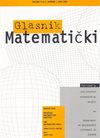素幂群的进一步研究问题和定理
IF 0.5
4区 数学
Q3 MATHEMATICS
引用次数: 1
摘要
4101. 描述指标p, k∈{2,3,4}的子群均为正态的p群(三个问题)。详细考虑第4102页的指数群。研究非abel p群G的极大阿贝尔子群都是正规的(G的任意两个元素生成一个类≤2的子群,因此根据[B1]中的定理7.1(b),如果p > 2,我们的群是正规的)。详细考虑p = 2的情况。4103. 求阶为p. 4104的极大类群的自同构群的极大可能阶。研究非正常亚群所覆盖的非dedekindian p群。4105. 研究p群G中任意两个等阶(不同阶)的非关联子群A和B的交正态(i)在A或B中,(ii)在< A,B >中。4106. 研究p群G的所有等阶非abel子群都是同构的(置换的)。详细考虑exp(G) = p的情况。本文章由计算机程序翻译,如有差异,请以英文原文为准。
Further research problems and theorems on prime power groups
4101. Describe the p-groups all of whose subgroups of index p, k ∈ {2, 3, 4}, are normal (three problems). Consider in detail the groups of exponent p. 4102. Study the nonabelian p-groups G all of whose maximal abelian subgroups are normal (any two elements of G generate a subgroup of class ≤ 2 so our group is regular if p > 2, by Theorem 7.1(b) in [B1]). Consider in detail the case p = 2. 4103. Find the maximal possible order of the automorphism groups of the groups of maximal class of order p. 4104. Study the non-Dedekindian p-groups covered by nonnormal subgroups. 4105. Study the p-groups G in which the intersection of any two nonincident subgroups, say A and B, of equal order (of different orders) is normal (i) either in A or in B, (ii) in 〈A,B〉. 4106. Study the p-groups G all of whose nonabelian subgroups of equal order are isomorphic (permutable). Consider in detail the case when exp(G) = p.
求助全文
通过发布文献求助,成功后即可免费获取论文全文。
去求助
来源期刊

Glasnik Matematicki
MATHEMATICS, APPLIED-MATHEMATICS
CiteScore
0.80
自引率
0.00%
发文量
11
审稿时长
>12 weeks
期刊介绍:
Glasnik Matematicki publishes original research papers from all fields of pure and applied mathematics. The journal is published semiannually, in June and in December.
 求助内容:
求助内容: 应助结果提醒方式:
应助结果提醒方式:


